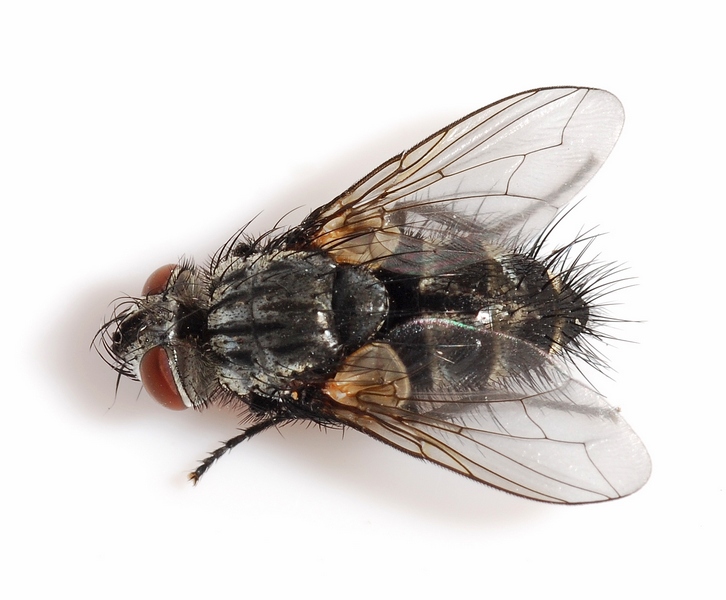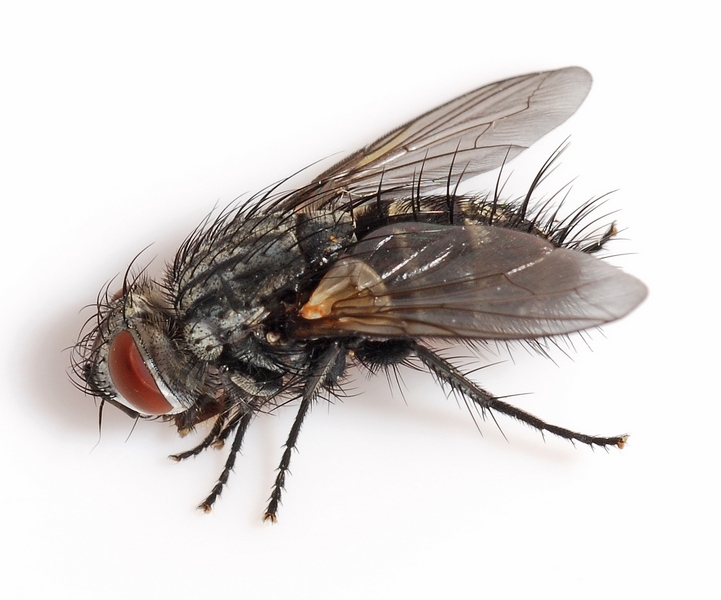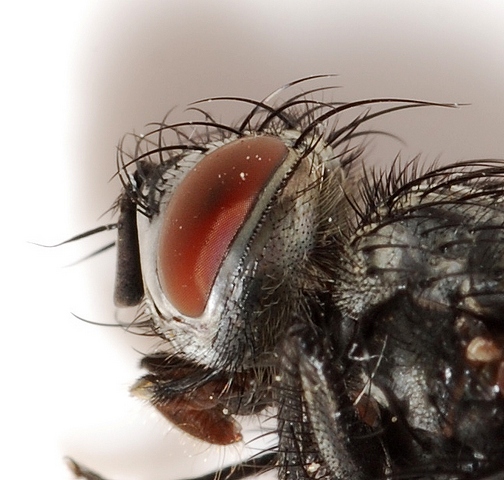Diptera.info :: Identification queries :: Diptera (adults)
Who is here? 1 guest(s)
|
Tachinidae from my garden
|
|
| peterbolson |
Posted on 03-08-2010 19:29
|
|
Member Location: Cumbria, UK Posts: 276 Joined: 07.06.10 |
I'm sure that this will be another common one but I'd be grateful for an ID. I can take more photos if needed. Thanks Peter peterbolson attached the following image:  [141.17Kb] |
|
|
|
| peterbolson |
Posted on 03-08-2010 19:30
|
|
Member Location: Cumbria, UK Posts: 276 Joined: 07.06.10 |
another
peterbolson attached the following image:  [144.99Kb] |
|
|
|
| Zeegers |
Posted on 03-08-2010 20:31
|
|
Member Location: Soest, NL Posts: 18948 Joined: 21.07.04 |
Where is your garden and what is in it ? Reed ? Mais ? This seems to be a female Lydella, either thompsoni or stabulans. If you can provide a lateral headshot (dead lateral that is), I might be able to tell more. Theo |
|
|
|
| ChrisR |
Posted on 03-08-2010 21:27
|
|
Super Administrator Location: Reading, England Posts: 7703 Joined: 12.07.04 |
Lydella stabulans have been doing the rounds recently - a rather non-descript genus though ... how many katepisternal bristles are there? I keep trying to make Lydella stabulans into thompsoni but so far it is still not a UK species  Though we now have some work on our hands because Eumea mitis was discovered last year, meaning that we have to back-check all E.linearicornis in collections Though we now have some work on our hands because Eumea mitis was discovered last year, meaning that we have to back-check all E.linearicornis in collections 
Manager of the UK Species Inventory in the Angela Marmont Centre for UK Biodiversity at the Natural History Museum, London. |
| peterbolson |
Posted on 03-08-2010 22:09
|
|
Member Location: Cumbria, UK Posts: 276 Joined: 07.06.10 |
Thanks Theo My garden is quite large with mature trees, flowers and a small pond. It has a rough common to one side grazed by sheep with lots of rushes and a large pond. Next to that is open moorland. Not a very good photo I'm afraid but is it any help ? Is there anything I could look for with the microscope ? Peter peterbolson attached the following image:  [132.8Kb] |
|
|
|
| Zeegers |
Posted on 04-08-2010 11:34
|
|
Member Location: Soest, NL Posts: 18948 Joined: 21.07.04 |
Thank you. It is very tricky, but it is L. thompsoni in my opinion. SO, was it reed or mais in your garden ? Theo |
|
|
|
| ChrisR |
Posted on 04-08-2010 12:49
|
|
Super Administrator Location: Reading, England Posts: 7703 Joined: 12.07.04 |
If Theo is fairly sure that it is Lydella thompsoni then it is worth sending it to me to be confirmed - it would be a 'new to the UK' and very exciting if it was. If you're happy to do that Peter then PM me and Ill give you my address. 
Manager of the UK Species Inventory in the Angela Marmont Centre for UK Biodiversity at the Natural History Museum, London. |
| peterbolson |
Posted on 04-08-2010 12:58
|
|
Member Location: Cumbria, UK Posts: 276 Joined: 07.06.10 |
Hi Theo and Chris I see what Theo was getting at now as I read that it parasitises the European cornborer. The only problem is that this is a pastoral area with sheep & cows. The nearest cornfield that I know of is about a mile away and this is the first year that any cereals have been grown round here. having sais that we do however feed a lot of corn to our chickens and doves and there are odd bits of corn growing round the garden ! Peter |
|
|
|
| Zeegers |
Posted on 05-08-2010 10:56
|
|
Member Location: Soest, NL Posts: 18948 Joined: 21.07.04 |
Ok an explanation for Peter. L. thompsoni is supposed to be a parasitoid on Ostrinia nubilalis, the corn stemboring Micro. However, it has also been bred from Nonagria and other stemboring Noctuidae in based on bred material and habitats in Netherlands, I'd say with us Nonagria is the primary host. So it you have reed, you can have Nonagria. I'd never realized that thompsoni would be new to the UK. As said, it is a tough call, so let me explain * arista not largely thickened, so no grisescens * third antennal segment long (2.5 - 3 x second) * bend of vein M only slightly further from wing margin than from crossvein m-cu * profile of face should be completely convex, and though the angle is not dead straight, so it seems in the last pic. I think more pics are not helping (me), I would need to play with the specimen myself, of course, Tschorsnig can do it even better. Theo |
|
|
|
| peterbolson |
Posted on 05-08-2010 12:48
|
|
Member Location: Cumbria, UK Posts: 276 Joined: 07.06.10 |
Thanks for that interesting information Theo. I have run a moth trap in my garden for several years and have never, to my knowledge, caught Nongaria typhae ( Bulrush wainscot ) although I have had several other types of Wainscot. The large pond I mentioned just outside my garden used to have Typha latifolia growing in it but, to my disappointment, it was removed 4 or 5 years ago. I don't have any in my garden. I have sent the specimen to Chris so hopefully he will come up with the answer  Best wishes Peter |
|
|
|
| ChrisR |
Posted on 05-08-2010 12:59
|
|
Super Administrator Location: Reading, England Posts: 7703 Joined: 12.07.04 |
Peter is in the process of sending the specimen to me so we should have an answer soon (post willing) 
Manager of the UK Species Inventory in the Angela Marmont Centre for UK Biodiversity at the Natural History Museum, London. |
| ChrisR |
Posted on 07-08-2010 13:11
|
|
Super Administrator Location: Reading, England Posts: 7703 Joined: 12.07.04 |
The specimen has arrived but it got a bit bedraggled/dirty in transit so I am washing it in ethyl-acetate to remove any grease etc. So far though I am not really convinced that it is L.thompsoni ... antenna-3 seems to be about 2x antenna-2 and the median vein between m-cu and the bend is definitely shorter than the distance from the bend to the nearest piece of wing-margin, which would all point to L.stabulans but when I get it cleaned and mounted properly I will test the facial-ridge shape and dusting features 
Manager of the UK Species Inventory in the Angela Marmont Centre for UK Biodiversity at the Natural History Museum, London. |
| ChrisR |
Posted on 08-08-2010 21:18
|
|
Super Administrator Location: Reading, England Posts: 7703 Joined: 12.07.04 |
OK, I have just looked at the specimen closely and I really can't make it L.thompsoni ... so it has to be L.stabulans. The face is slightly concave at the base ... the antenna-3 is definitely shorter than 1.9x the longest side of antenna-2 ... m-cu to the bend is much shorter than the bend to the nearest wing marging etc, etc. Sorry Peter ... no new species yet 
Manager of the UK Species Inventory in the Angela Marmont Centre for UK Biodiversity at the Natural History Museum, London. |
| Jaakko |
Posted on 10-08-2010 10:00
|
|
Member Location: Joensuu, Finland Posts: 479 Joined: 04.08.08 |
Murphys law for entomologists: when you check a couple of hundred specimens of a difficult species group (usually also making genital preps), they all end up being the most common species of the group. |
|
|
|
| Zeegers |
Posted on 10-08-2010 20:02
|
|
Member Location: Soest, NL Posts: 18948 Joined: 21.07.04 |
As said,one really needed to see the specimen, the antennae seems really longer, which was the mean ground for my suggestion. If you measure the picture, it seems really longer, but alas. Theo |
|
|
|
| ChrisR |
Posted on 10-08-2010 20:14
|
|
Super Administrator Location: Reading, England Posts: 7703 Joined: 12.07.04 |
I suppose it depends how antenna-2 is measured - the inside facet is longer than the outside. But it seemed to fail on all counts - not just one.
Manager of the UK Species Inventory in the Angela Marmont Centre for UK Biodiversity at the Natural History Museum, London. |
| Jump to Forum: |













